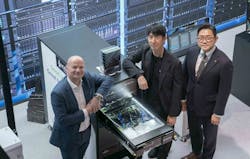Immersion Cooling Is Ready for its Big Moment in the Data Center
It’s clear that the market for immersion cooling has reached a tipping point. With the rapid adoption of AI technologies and AI’s demand for power, density, and cooling we’ve likely rushed right past the tipping point and are hurtling towards the precipice.
But there is so much built-up demand for AI solutions, it seems like it will be quite a while before demand drops off, and in the meantime, liquid immersion cooling has yet to come anywhere near peak demand.
Why Immersion Cooling?
With all the discussion of data centers building to support AI, higher rack densities, and greater power demands, the cooling aspect is often simply considered a given.
If my colocation data center is enabling rack densities in the 50 kW-250 kW range, they must be able to cool the system running and using all that power. From relatively simple solutions such as rear door heat exchangers to direct-to-chip liquid cooling to full-blown immersion cooling, there are quite a few options and their associated vendors appearing to meet the various levels of demand.
But immersion cooling brings several advantages to the cooling environment that more than offset what have been perceived as disadvantages.
Immersion Cooling Upside and Advantages
The number one disadvantage most often cited for immersion cooling was that it was most suitable for HPC and AI solutions demanding 100 kW per rack or maore of cooling capacity.
In this case, the mountain has come to Mohammed, as the data center industry no longer considers high rack densities an outlier. They are a primary consideration in the design of new data centers and adding capacity to existing facilities.
Equipment manufacturers no longer look askance when their equipment is modified to work in an immersion environment, and the additional costs of building immersion cooling system are being offset by higher cooling efficiency and better sustainability numbers.
The potential advantages of an immersion cooling design for your data center are numerous and are focused on areas of concern that are often dominating data center discussions today.
These include the challenges of energy consumption, density, environmental impact, and operational efficiency, a group of concerns that need to be individually dealt with but are intricately interwoven in today’s data center world.
The areas most directly impacted include:
- Energy Efficiency
- Immersion cooling is more energy efficient than air cooling or many other forms of liquid cooling. This is true for a couple of reasons, primarily that liquid is better than heat absorption than air but also features such as the absence of fans on every system. There is no additional cooling hardware beyond the immersion cooling system necessary.
- Higher Hardware Density
- Immersion cooling allows for higher server density within racks, significantly surpassing the capacity of traditional cooling methods.
- Improved Reliability
- Studies have shown that cooling by immersion in non-conductive fluids has reduced hardware failures. There are no longer concerns such as humidity changes, significant temperature fluctuations, vibration and other issues that are often causes of mechanical hardware failure.
- Improved Sustainability and Lessened Environmental Impact
- The immersion cooling technology minimizes energy consumption and eliminates the requirement for water as part of the cooling process, directly addressing a major environmental concern in the siting of data centers. The technology also helps drive net-zero carbon initiatives and allows for a better, overall, environmental footprint for a data center.
- Overall Improvements in Operational Efforts
- Reduced operational costs, better efficiency, and more effective processes for managing heat generated by high-density and high-performance compute resources.
Is All Immersion Cooling the Same?
Beyond the vendor-to-vendor differences, there are two major types of immersion cooling, single-phase and two-phase. While both methodologies involve submerging servers in non-conductive liquid, the differences are in how the heat being generated is handled.
Single-phase immersion cooling uses a thermally conductive dielectric liquid or coolant, either an engineered fluid or mineral oil. The servers and other IT equipment are submerged in the coolant, which remains in a liquid state throughout the cooling cycle, and the coolant, which is in direct contact with the heat-generating equipment, is then circulated through the immersion tanks, most often using pumps, to an external heat exchanger, then back to the tanks.
Two-phase immersion cooling is a bit more complicated. While component systems are still placed in a tank of specialized dielectric fluid, the fluid, in this case, has been selected because it changes from liquid to gas at a relatively low temperature that is lower than the operating temperature of the electronic components. Because the immersion fluid has a low boiling point, the boiling causes the fluid to change state, from liquid to gas. This type of phase change makes for a very efficient method of removing heat due to the vaporization process.
The vapor created rises to a cooler part of the tank and comes in contact with condenser coils, which can be kept cool with either air or water cooling processes. The gas condenses back to liquid and is then returned to the tank where the process starts over. This represents a very efficient closed-loop cycle.
Who Are the Current Big Players in the Immersion Cooling Market?
As the liquid cooling market has grown, many players have joined the field, though in this case we are interested only in those with a focus on immersion cooling. Many of these companies are very specialized in immersion technology, while a few include immersion in their portfolio of liquid cooling solutions.
Green Revolution Cooling
One of the very first companies to focus on immersion cooling, GRC launched in 2009 with their single-phase immersion cooling solution.
Last August, GRC was awarded ISO 9001:2015 Quality Management System certification for designing, manufacturing, and providing installation services for immersion cooling products for use worldwide. Also in 2023, GRC launched a single-phase immersion cooling platform for blockchain applications; the HashRaQ MAX system tackles the extreme heat loads generated by cryptomining.
In 2022, GRC secured a $28 million Series C equity investment led by South Korea-based SK Lubricants. In 2021, GRC pioneered a new immersion cooling design for extreme-density computing involving up to 200 kilowatts (kW) of server capacity.
Last October, GRC and DCV announced a collaboration to launch immersion-cooled data centers in the Middle East. Incorporating DCV’s environmentally sound containerized data center enclosures and Dell’s high-density server technologies, the relationship aims to offer organizations in the region a comprehensive means to significantly reduce data center build, maintenance, and power costs when compared to air-cooled facilities, according to GRC.
Liquidstack
Liquidstack offers customers a dedicated pilot program with a 4U system to evaluate their 2-phase immersion cooling technologies.
Last year, LiquidStack received an investment from Trane Technologies, the global HVAC giant. The investment is enabling LiquidStack to build a manufacturing facility and R&D lab in the United States.
Created as a liquid cooling unit inside The Bitfury Group, a crypto mining company, in 2021 LiquidStack was spun out as a stand-alone company with $10 million in Series A funding from hyperscale hardware maker Wiwynn, and ambitions to address growing cooling challenges in cloud data centers and high-performance computing (HPC).
The investment from Trane is advancing those ambitions. Last November, LiquidStack unveiled is single-phase immersion cooling offering at DCD Connect | Virginia. Also last November, LiquidStack entered the direct-to-chip liquid cooling market, introducing a new range of universal coolant distribution units (CDUs).
Iceotope
Iceotope Technologies uses a slightly different technology they call Precision Liquid Cooling where only the IT workload hotspots are targeted for cooling.
As noted by Data Center Frontier's Rich Miller, a $35 million funding for immersion cooling specialist Iceotope in 2022 illustrated growing investor confidence in the future of immersion cooling, which even then appeared poised to move beyond its historic niches in high-performance computing (HPC) and cryptocurrency.
The £30m (about $35.7 million US) funding round came from a global investment syndicate led by Singapore private equity firm ABC Impact. The syndicate includes strategic investments from nVent – a leading global provider of electrical connection and protection solutions – along with SDCL Energy Efficiency Income Trust, Northern Gritstone, British Patient Capital, Pavilion Capital, and existing investor, Edinv.
Earlier this month, Iceotope announced its achievement of a chip cooling industry milestone at 1000W, via published results in achieving chip cooling at 1000W and beyond with its single phase Precision Liquid Cooling system. It's critical for data center operators to know they are future-proofing their infrastructure investment for 1000W to 1500W to 2000W CPUs and GPUs in coming years. The testing conducted by Iceotope Labs demonstrated how Precision Liquid Cooling technology is expected to meet these challenges.
Also this month, Iceotope was seen positioning its Precision Liquid Cooling as a way to significantly reduce telco operators’ total energy costs, while noting how an advanced edge sustainability strategy including Precision Liquid Cooling can reduce telco operators' energy usage and carbon emissions.
Finally, at this week's Mobile World Congress (MWC Barcelona 2024), SK Telecom, Iceotope Technologies, and SK Enmove, Korea's leading base oil and lubricants provider developing thermal fluids for data centers, signed a memorandum of understanding (MOU) to collaborate on the development of liquid cooling technique/solution that optimizes energy-efficiency for AI data centers.
Liquidcool
Liquidcool’s approach combines direct-to-chip cooling and total immersion cooling in a standard 19” data center rack.
Last October, Ken Krei, CEO of LiquidCool Solutions and David Jackson, CEO of ServerDomes have announced a collaboration to expand the distribution of LiquidCool's rack-based, liquid-cooled servers while increasing the efficiency and capacity of ServerDomes' edge data centers offering. The edge platform primarily uses biomimicry to remove heat and control the data center environment, resulting in 27% less power usage, over 92% less water usage, and requiring only an acre of land for a 2 MW to 6 MW facility, as stated by the company.
Midas Immersion Cooling
Midas offers a selection of full immersion cooling systems that they claim are both more energy and space efficient than traditional air cooling. They offer a variety of different approached to full immersion. Data Center Frontier's Rich Miller highlighted Midas Immersion Cooling in a photo feature of some of the cutting-edge liquid cooling gear on display at demos on the expo floor at last year's Data Center World.
Last July, Midas entered into a long-term supply agreement with Riot Platforms, Inc. (NASDAQ: RIOT), a specialist in BTC mining and data center hosting. The agreement includes an initial purchase of 200 MW of immersion systems, with the option to supply up to 400 MW of additional immersion systems on the same terms. The initial sale brought total worldwide deployment of Midas Immersion Cooling systems up to 0.5 GW.
About the Author

David Chernicoff
Matt Vincent
A B2B technology journalist and editor with more than two decades of experience, Matt Vincent is Editor in Chief of Data Center Frontier.




